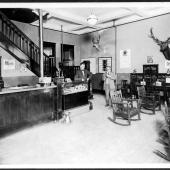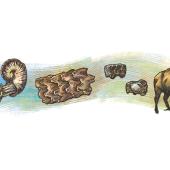They Never Left: Lewis and Clark's Travels Through the Hearts of Montanans

Photo by Hallie Zolynski
I have a theory that Lewis and Clark never left Montana.
Of course they did leave our fair state, not yet a state at the time. In fact, they left it twice in 1805, and once again in August of 1806.
But they never really left.
To wit, ever since I was a kid and would get lost hiking with a companion, I'd turn to the other person and say, "Okay, Clark," or Lewis, if that person was being more of a Lewis than a Clark, "Which way do we go now?"
But my recollections of the Lewis and Clark expedition are from history books and interpretive centers. So I decided to head out into people's backyards and breweries.
My first stop was at the home of Frank and Lois, who have lived along the Dearborn River, a tributary of the Missouri, since 1972. Their home sits beautifully along the banks of the river. As I got out of the car, Frank came out of the garage, all smiles in his flannel shirt and suspenders, telling me Lois was back from town. It felt like I knew them already, and this was just one of our everyday visits.
As we walked into the house, I was taken back to my grandparents' home, with the electric coffee pot on the counter and its smell of coffee that's been on for too long in the air, doilies on every surface, and everything in its place. Lois asked if I want some coffee. It would be an insult to say no, so while the coffee brewed, we made small talk about the river, the weather, and Frank's days as a plumber.

Photo by Hallie Zolynski
Lois's coffee was as strong as her attitude, and I enjoyed the under-the-breath comments she made during Frank's storytelling. I asked them if they had any personal stories of the Lewis and Clark expedition. Lois said, "No, and quite frankly, I am getting a bit sick and tired of them," like they were a guest who had overstayed their welcome. I got the sense she'd heard Frank's stories before.
Then, right on cue, Frank said, "The only thing I know is that rock outside across the river, you see, is in their journal, and they called it Mountain Palace. And do you remember the rapids they couldn't get over? Well, I ran them once in a canoe…."
I perked up instantly, which was probably a combination of interest and Lois's coffee beginning to take.
Frank recounted his experience. "We had talked to Lois's dad, who worked at Black Eagle Dam, and asked if he knew of anything dangerous down the river that could do you in. My friend, of all things, had a 12 gauge shotgun that had never even been fired yet. We loaded everything into my 1977 Grand Prix Pontiac, put the canoe into the river at Maroney Dam, tied everything off real good. Well, Sacagawea ..."
This was when Lois stepped in and said, "Come on, Frank, get to the point." He didn’t skip a beat and continued with, "Sacagawea was ill and went to soak in the sulfur springs. Right down by the springs two miles on the Missouri River, about a half-mile below where Bell Creek comes into the river, everyone said there are little rapids there that are no sweat. So we are already throwing our lures in, and my friend was standing up in fact, and he says, 'Did you hear a roar by any chance?' And I said no, I hadn't. It wasn't long, and we saw the wind was coming out of the north, and we were in the middle of the river, and there is these seven-foot rapids that go all the way across the river that stopped Lewis on their expedition. We couldn't get to shore, and I had a horse and a half Evinrude on the back, and the only thing I ended up with after that rapid was the two tighteners. It's called Big Eddy, and it ate us alive. We watched our stuff go by, we went upside down, and we were on those big rocks down there." I asked what year this was. Lois said, "1910."

Photo by Hallie Zolynski
We all laughed at that one, and Frank kept going.
"It was in 1984. We gathered what we could of our gear, which wasn't much. We were soaked, and it's getting dark, the paddles were gone... we had some candles, and from the light of the candles, a lady in a truck saw us and saved us."
I could tell Frank was quite proud that he ran the rapids that had stopped Lewis. We went outside to take a look at Mountain Palace and watch some boaters go by. It was hard to say goodbye.
As I traveled toward Fort Benton, the plains seemed to become vaster as the Highwood and Bear Paw Mountains stood tall off in the distance. In Fort Benton, I got something to eat and listened to the band Stick and String at the Public House. The violinist, Karen Pogorzelski, likes to play music from the Lewis and Clark era and told me Lewis and Clark had a couple of violinists with them, and music was an important part of the expedition. As I listened, my imagination ran wild with images of the expedition party dancing to the music and the haunting tunes echoing across the river.
That night I stayed at the Virgelle Mercantile, built in 1912 for the railroad crews. Don Sorensen runs the Mercantile now as a bed and breakfast. Over breakfast, we chatted about the days of Lewis and Clark, and although he didn’t have any wild stories like Frank, he told of how he enjoys living off the beaten path and giving guests a glimpse into the life of Montana in the early 1900s.
Next, I was ready to join Nicolle Fugere, who runs the Missouri River Outfitters, on a canoe trip down the Missouri to go check out a couple of campsites of Lewis and Clark’s, when she told me that the plans had changed and instead asked if I would like to go help brand cows at a ranch down the road. I switched gears and followed her down a dirt road that seemed to go on for miles. As we pulled up, I was taken aback by the sheer beauty of the place. It felt like I had stepped back in time as I took in the barns and the home that I found out were built around the 1860s. It is one of the largest and oldest working ranches in Montana and used to house the horses for the cavalry.

Photo by Hallie Zolynski
I spent the better half of the day with the Kelly family helping brand, and when I say help, I actually mean staying out of the way and taking photographs. After the calves were branded and let loose to find their mothers, the dad showed me an old cottonwood tree and pointed out across the Teton River to large grooves that head into the river.
The ridge above the river is a buffalo jump, he told me, and the grooves are from years of travel from the buffalo crossing toward greener grass. The Blackfeet considered this area sacred, and the cottonwood was a burial tree; the family worked their irrigation pivots around it so that the cottonwood is a very prominent feature in the center of their flourishing fields. He said every so often, after a heavy rain, buffalo skulls will wash up onto the shore. I asked if they had ever found anything that might be from the Lewis and Clark expedition, and he said they sometimes find pieces of old metal, but not much.
We parted ways, and I headed to Big Sandy to meet up with a retired shop teacher Bob Nelson.
I met Bob at Pep's Bar, instantly picking him out by the books he was carrying. Bob said he has always enjoyed studying the history of the expedition, and there is one part that intrigues him in particular. "When the expedition in April hit Slaughter River, called Arrow Creek now, what always bothered me was when [historians and archivists] Ambrose and Moulton came by and rewrote the journals, everything Lewis and Clark said was gospel. Except that day, they hit the river and the pishkuns (buffalo jumps)—the problem was they didn't know where it exactly was, so they found what they thought it was and put that down. But after going there and doing my own research, I found the spot it actually was, which isn't what Ambrose put down."
Bob told me he has gone back to that site plenty of times, and that he reckons the journals are off by about three weeks, offering by way of proof a Bodmer painting done when Prince Maximillian went through the area that apparently depicts the pishkun and refutes the explorers' accounts. Bob told me that he also intends to solve the mystery of why the native plants Lewis and Clark collected and stashed at Decision Point in Loma were never found. Ever the iconoclast, Bob has quite a few areas of interest that he feels bear revisiting. I confessed that, though I was not equipped to judge the veracity of his claims, hearing them espoused with such verve made them sound pretty darn compelling.
As I headed home, not in a pirogue but in the cab of a pickup filled nearly to capacity with my two dogs, Ranger and Charlie, I reflected that we'll probably never know precisely what really happened in those few scant months in the early years of the 19th century. But we can sure argue about it over a beer or a cup of coffee.
Somehow, while taking a scenic detour, Ranger, Charlie, and I ended up a bit lost on a backroad turned to slush by the late thaw. I wasn't sure how to get back to the highway or, in fact, where exactly I was at all.
Flummoxed, I stopped the truck, pulled over, and looked my crew right in their furry eyes.

Photo by Hallie Zolynski












- Reply
Permalink